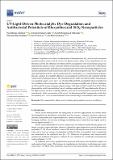Por favor, use este identificador para citar o enlazar a este item:
http://hdl.handle.net/10261/334432COMPARTIR / EXPORTAR:
 SHARE SHARE
 CORE
BASE CORE
BASE
|
|
| Visualizar otros formatos: MARC | Dublin Core | RDF | ORE | MODS | METS | DIDL | DATACITE | |

| Título: | UV-Light-Driven Photocatalytic Dye Degradation and Antibacterial Potentials of Biosynthesized SiO2 Nanoparticles |
Autor: | Chelliah, Parvathiraja; Gupta, Jeetendra Kumar; Mohammad Wabaidur, Saikh; Siddiqui, Masoom Raza; Lee, Siaw Foon CSIC ORCID; Lai, Wen-Cheng | Palabras clave: | SiO2 nanoparticles Silicon Green synthesis Photocatalysis Jasminum grandiflorum |
Fecha de publicación: | 18-ago-2023 | Editor: | Multidisciplinary Digital Publishing Institute | Citación: | Water 15(16): 2973 (2023) | Resumen: | The present work shows the obtainment of biosynthesized SiO2 with the aid of Jasminum grandiflorum plant extract and the study of its photocatalytic ability in dye degradation and antibacterial activity. The obtained biosynthesized SiO2 nanoparticles were characterized using X-ray diffractometer analysis, Fourier transform infrared spectroscopy analysis, ultraviolet–visible diffuse reflectance spectroscopy, field-emission scanning electron microscope with energy-dispersive X-ray analysis, transmission electron microscopy and X-ray photoelectron spectroscopy. The UV-light irradiated photocatalytic activity of the biosynthesized SiO2 nanoparticles was examined using methylene blue dye solution. Its reusability efficiency was determined over 20 cycles and compared with the commercial P-25 titanium dioxide. The bacterial resistivity of the biosynthesized SiO2 nanoparticles was examined using S. aureus and E. coli. The biosynthesized SiO2 nanoparticles showed a high level of crystallinity with no impurities, and they had an optimum crystallite size of 23 nm, a bandgap of 4 eV, no Si-OH groups and quasi-spherical shapes with Si-2p at 104 eV and O-1s at 533 eV. Their photocatalytic activity on methylene blue dye solution could reach 90% degradation after 40 min of UV light exposure, and their reusability efficiency was only 4% less than that of commercial P-25 titanium dioxide. At the concentration of 100 μg/mL, the biosynthesized SiO2 nanoparticles could allow the resistivity of E. coli to become borderline to the resistant range of an antibiotic called Amikacin. | Versión del editor: | https://doi.org/10.3390/w15162973 | URI: | http://hdl.handle.net/10261/334432 | DOI: | 10.3390/w15162973 | E-ISSN: | 2073-4441 |
| Aparece en las colecciones: | (IETCC) Artículos |
Ficheros en este ítem:
| Fichero | Descripción | Tamaño | Formato | |
|---|---|---|---|---|
| UV-Light-Driven_Chelliah.pdf | 6,78 MB | Adobe PDF |  Visualizar/Abrir |
CORE Recommender
SCOPUSTM
Citations
1
checked on 26-abr-2024
Page view(s)
51
checked on 03-may-2024
Download(s)
16
checked on 03-may-2024
Google ScholarTM
Check
Altmetric
Altmetric
Este item está licenciado bajo una Licencia Creative Commons

